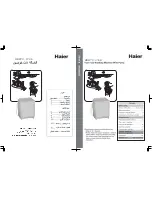
162
EN
MNV8060ds
UNSUITABLE COOKWARE
• Cutlery and dishware with wooden parts.
• Plastic dishware and dishware with glued parts that are not heat resistant.
• Glued items, cutlery or plates.
• Tin or copper dishware.
• Crystal glass.
• Steel items prone to rusting.
• Wooden bowls.
• Objects made of synthetic fibres.
Some aluminium and silver parts may change colour or fade.
Certain types of glass can tarnish after several washing cycles.
Note:
• Do not put absorbent materials such as sponges and cloths in the dishwasher.
• Use detergents which are labelled by a manufacturer as gentle to dishes.
• Wash only the dishes confirmed to be suitable for washing in dishwashers.
• Do not wash dishes soiled with ash, wax, grease or paint in the dishwasher!
LOADING DISHWARE
Placing dishware
Remove large food residues from the dishes. Rinsing dishes under the tap before washing in the dishwasher is not
necessary.
Load the dishes in the following manner:
• Place cups, glasses, pots, pans, etc. upside down.
• Place the dishes with hollows diagonally to allow excess water to drain and for best results of drying.
• Dishware must be loaded securely to avoid falling.
• Loaded dishes must not impede the spray arms to rotate freely.
• Dishware and cutlery should not lie on one another or cover each other.
• Glasses should not touch each other to avoid possible damage.
• Load pots and larger dishes in the lower rack.
• The upper rack is designed for loading of smaller and lighter dishware (glasses, cups, etc.).
• Long-bladed knives placed upright are very dangerous! Be careful, risk of injury!
• Long and sharp cutlery (carving knives) must be placed horizontally in the upper rack.
• Do not wash very small items in the dishwasher as they can easily slip out of the racks.
• Do not overload the dishwasher!
Содержание MNV8060ds
Страница 2: ......
Страница 4: ...4 MNV8060ds CZ ...
Страница 140: ...140 LV MNV8060ds pieskrūvējiet trauku mazgājamās mašīnas sānus skapīšiem 7 solis Kondensācijas lente Nosegpanelis ...
Страница 184: ......
















































